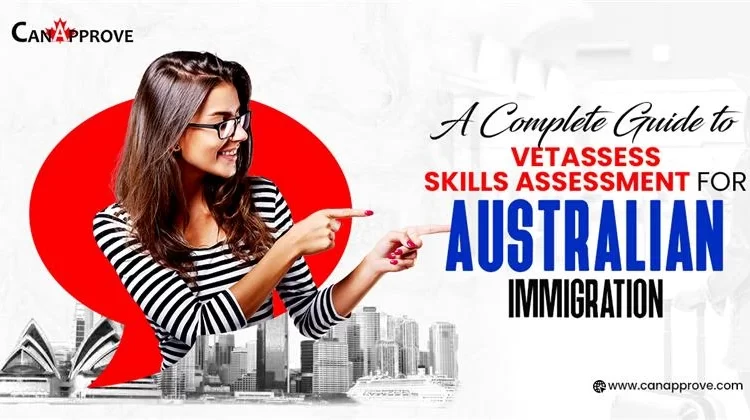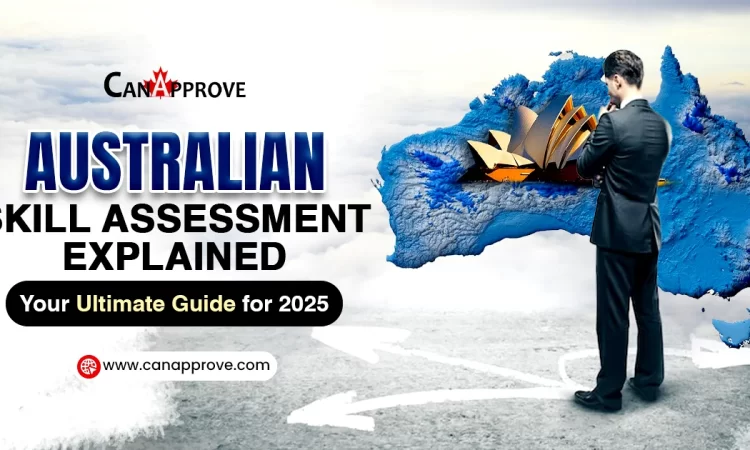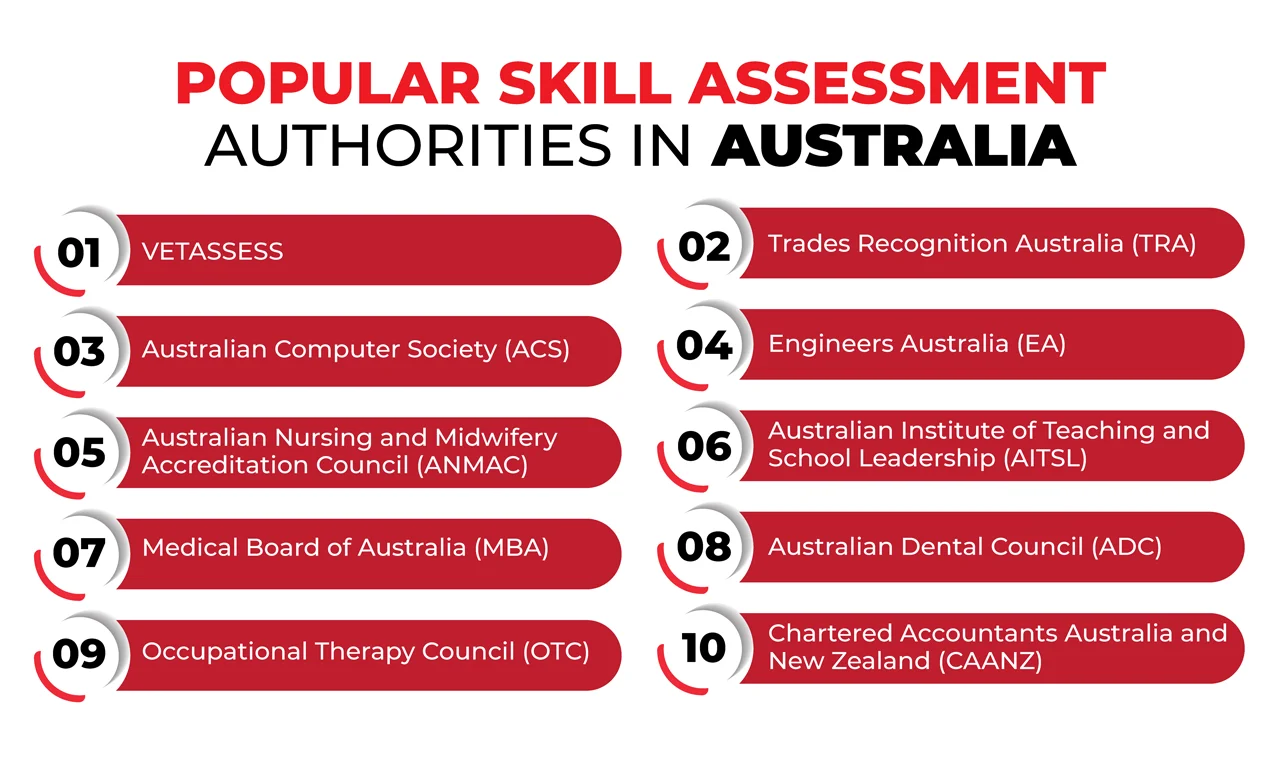If you’re planning to migrate to Australia, the VETASSESS Skills Assessment is a key step in the process. Whether you’re applying for a skilled migration visa or looking for work opportunities, getting a positive skill assessment from VETASSESS is crucial to proving your qualifications and experience in your chosen field.
This guide will walk you through the VETASSESS skills assessment process step by step, making it simpler for skilled professionals like you to move forward with confidence and achieve a successful migration outcome!
Tabel Of Content
1What is VETASSESS Skills Assessment?2VETASSESS Occupation List3Eligibility Criteria for VETASSESS Skills Assessment4VETASSESS Skills Assessment Checklist5How to Apply for VETASSESS Skills Assessment6VETASSESS Skills Assessment Fee7VETASSESS Processing Time8How to Get a Positive VETASSESS Skills Assessment9Common Reasons for Rejection10Frequently Asked Questions
What is VETASSESS Skills Assessment
VETASSESS (Vocational Education and Training Assessment Services) is Australia’s leading skills assessment authority for various professional and trade occupations. The VETASSESS skills assessment assesses the qualifications and work experience of applicants seeking to migrate to Australia under skilled visa programs.
Why is a Skills Assessment Important?
A positive skills assessment is a mandatory requirement for many skilled migration visas, including:
- Subclass 189 (Skilled Independent Visa)
- Subclass 190 (Skilled Nominated Visa)
- Subclass 491 (Skilled Work Regional (Provisional) Visa)
The assessment makes sure that your qualifications and experience meet Australian standards for your nominated occupation.
VETASSESS Occupation List
The VETASSESS skills assessment evaluates a wide range of occupations classified under different groups:
General Professional Occupations: VETASSESS assesses more than 341 professional and other non-trade occupations across various industries.
Trade Occupations: VETASSESS also assesses over 27 trade occupations.
Before applying, make sure that your occupation is listed under VETASSESS’s eligible skilled occupations by checking their official occupation list page.
Eligibility Criteria for VETASSESS Skills Assessment
To qualify for a VETASSESS skills assessment, you must meet specific eligibility requirements:
Nominated Occupation: Your occupation must be listed under VETASSESS’s eligible skilled occupations.
Educational Qualifications: You must have the necessary educational qualifications relevant to your occupation. VETASSESS will compare your qualifications against the Australian Qualifications Framework (AQF) to determine their equivalence.
Work Experience: You should possess sufficient work experience at an appropriate skill level as required for your nominated occupation.
English Proficiency: Some occupations may require proof of English proficiency.
VETASSESS Skills Assessment Checklist
Before submitting your application for VETASSESS skills assessment, make sure you have the following required documents:
Resume / Curriculum Vitae (CV) – A detailed overview of your education and work experience.
Photograph – A recent passport-sized photograph.
Proof of Identity – Valid identification documents such as a passport or birth certificate.
Change of Name Documentation – If applicable, legal proof of name change.
Qualification Evidence – Academic transcripts and certificates demonstrating your education.
Employment Evidence – Reference letters, payslips, tax records, and other documents verifying your work experience.
Statutory Declaration or Affidavit – If required, a legally sworn document providing additional verification.
Application Fee – Fees vary based on the type of assessment. Find more information about VETASSESS fees here.
Make sure all documents meet VETASSESS’s format and submission requirements to avoid delays in your assessment.
How to Apply for VETASSESS Skill Assessment
Here’s a step-by-step guide to applying for a VETASSESS skills assessment:
Step 1: Nominate Your Occupation
- Choose an occupation from the VETASSESS Professional Occupations list.
- Check the qualification and employment requirements for your selected occupation.
Step 2: Check Your Occupation Description
- Review the detailed occupation description provided by VETASSESS.
- Make sure your work experience aligns with the listed responsibilities and requirements.
Step 3: Prepare Your Application
- Gather all required documents, including qualification and employment evidence.
- If you need additional guidance, consider VETASSESS’s Skills Assessment Support services.
- For faster processing, you can opt for Priority Processing.
Step 4: Apply Online
- Create an account on the VETASSESS website.
- Upload your documents and complete the online application form.
- Pay the required assessment fee and submit your application.
VETASSESS Skills Assessment Fee
As of November 20, 2024, VETASSESS updated its fees for skills assessments in professional and general occupations to align with inflation. Below is a summary of the current fees:
Full Skills Assessment Fees
| Assessment Type | Within Australia (AUD, incl. GST) | Outside Australia (AUD, excl. GST) |
|---|---|---|
| Full Skills Assessment (Qualifications & Employment) | $1,177.00 | $1,070.00 |
| Priority Processing (Additional Fee) | $886.60 | $806.00 |
Points Test Advice
| Assessment Type | Within Australia (AUD, incl. GST) | Outside Australia (AUD, excl. GST) |
|---|---|---|
| Points Test Advice | $334.40 | $304.00 |
For detailed and up-to-date information on fees, refer to the VETASSESS fees page.
VETASSESS Processing Time
For VETASSESS skills assessment the processing time can vary because every assessment is different for Australia immigration.
Standard Processing Time: Typically 10–12 weeks for general occupations
Trade Occupations Processing Time: May take longer due to practical assessments.
Priority Processing: Reduces assessment time significantly.
Processing times can vary, so it’s advisable to check the latest estimates on the VETASSESS website.
How to Get a Positive VETASSESS Skill Assessment
A positive VETASSESS skills assessment is very important for skilled migration to Australia. Here’s how you can achieve it:
Provide Accurate and Complete Documentation: Make sure all required documents are submitted and correctly formatted.
Align Qualifications with Australian Standards: Verify that your qualifications meet the AQF standards.
Demonstrate Relevant Work Experience: Clearly outline your work experience with supporting evidence.
Double-Check Submissions: Review all information for accuracy before submission.
Common Reasons for Rejection
A negative VETASSESS skills assessment can delay your Australian migration plans. Here are the most common reasons for rejection and how to avoid them:
1. Insufficient Work Experience
- Not meeting the minimum required experience (usually 1–3 years).
- Experience gained before completing the required qualification may not be counted.
Solution: Ensure you have the required years of post-qualification experience.
2. Unrelated Qualification
- Your degree/diploma is not closely related to your nominated occupation.
Solution: Choose an occupation that aligns with your studies OR provide additional work experience to compensate.
3. Poorly Written Employment Reference Letters
- Missing key details like job duties, work hours, or employer details.
- Duties not matching the ANZSCO code of your occupation.
Solution: Ensure your reference letter is detailed, on official letterhead, and signed by a superior or HR manager.
4. Incomplete or Incorrect Documents
- Missing payslips, tax records, contracts, or employer references.
- Submitting documents in a language other than English without certified translation.
Solution: Double-check the document checklist and get translations if required.
5. Employer Verification Issues
- If VETASSESS contacts your employer and cannot verify your work history.
- Fake or misleading employment details.
Solution: Inform your employer in advance about possible verification. Provide genuine documents only.
6. Self-Employment Without Proper Proof
- Business owners and freelancers failing to provide tax returns, invoices, or contracts.
Solution: Submit business registration documents, financial records, and client invoices as proof.
7. Incorrect Nominated Occupation
- Choosing an occupation that doesn’t match your skills or experience.
Solution: Select an occupation that aligns with your education and job responsibilities.
8. Failure to Respond to Additional Document Requests
- VETASSESS may ask for more documents. Failure to respond within the deadline leads to rejection
Solution: Regularly check your email and respond promptly.



